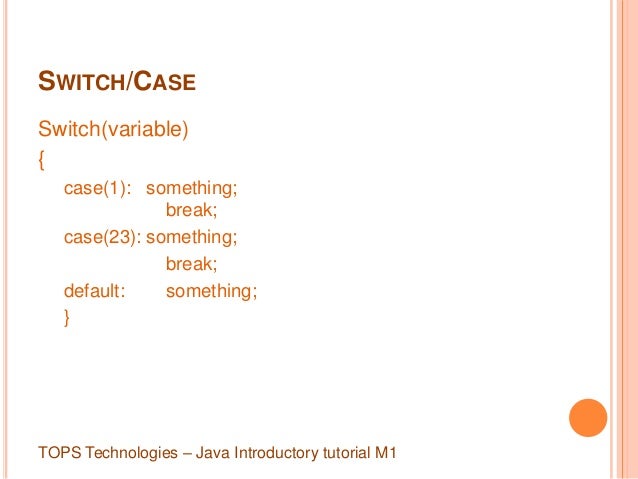

When there is no default block in the switch block ("Sorry none of your cases matched") break ("Congratulations here is the case 8 executed") break ("Congratulations here is the case 4 executed") break ("Congratulations here is the case 3 executed") break When the value of the Switch expression is matched with a Case value The below examples clearly show how the Case statement work in Java.
#Base switch case java code
return ‘true’ in any of the Case statements, then the code of a particular block is executed, and then execution exits the Switch block. If the value of any case is matched with the expression, i.e. false’ is returned at the end of every case, then the code inside the ‘default’ is executed. If the value is not matched until the last step, i.e. It shows how matching the expression defined in the Switch statement is matched with the Case value starting from the top until the last steps. The above flow diagram clearly shows how the Switch and Case statement works in Java. default is an optional case and executed if none of the case values matches the expression There can be as many Cases as the user wants in a Switch block same data type for switch expression and case value Case value1: Syntax of Switch Case Statement in Java switch (expression)

Break keyword in each Case is used to terminate that particular sequence of statements of that case.Variables are not allowed for the Case value.The data type of variable of switch statement needs to be the same as the Case statement value.Duplicate values in the Case statements are not allowed.There can be any number of Case statements in a single Switch block.There can be multiple switch blocks in the program, depending on the different conditions.

If none of the value matches case values, then the default statement defined in the Switch block is executed otherwise, nothing got executed. How Does Case Statement work in Java?Īs described above, Case in a particular Switch statement is executed when the value of the expression matches with the Case value. Though the default and break keywords are not mandatory in Switch-Case statements. If any of the values of the Case does not match with the expression, then the default statement is executed. With the Java JDK7, the value of the case can also be String, Wrapper and enumerated types. The Case values in Java can be byte, int, short, byte data types. It performs the execution of statement/statements when the value of the expression is matched with the case value, and the code of the particular statements is ended by break keyword. The case is a keyword that is used with the Switch statement. ("Your grade is " + grade) Ĭompile and run the above program using various command line arguments.The switch statement is a branch statement. The default case can be used for performing a task when none of the cases is true. If no break appears, the flow of control will fall through to subsequent cases until a break is reached.Ī switch statement can have an optional default case, which must appear at the end of the switch. When a break statement is reached, the switch terminates, and the flow of control jumps to the next line following the switch statement. When the variable being switched on is equal to a case, the statements following that case will execute until a break statement is reached. The value for a case must be the same data type as the variable in the switch and it must be a constant or a literal. Each case is followed by the value to be compared to and a colon. You can have any number of case statements within a switch. The variable used in a switch statement can only be integers, convertable integers (byte, short, char), strings and enums. The following rules apply to a switch statement − You can have any number of case statements. Each value is called a case, and the variable being switched on is checked for each case. A switch statement allows a variable to be tested for equality against a list of values.


 0 kommentar(er)
0 kommentar(er)
